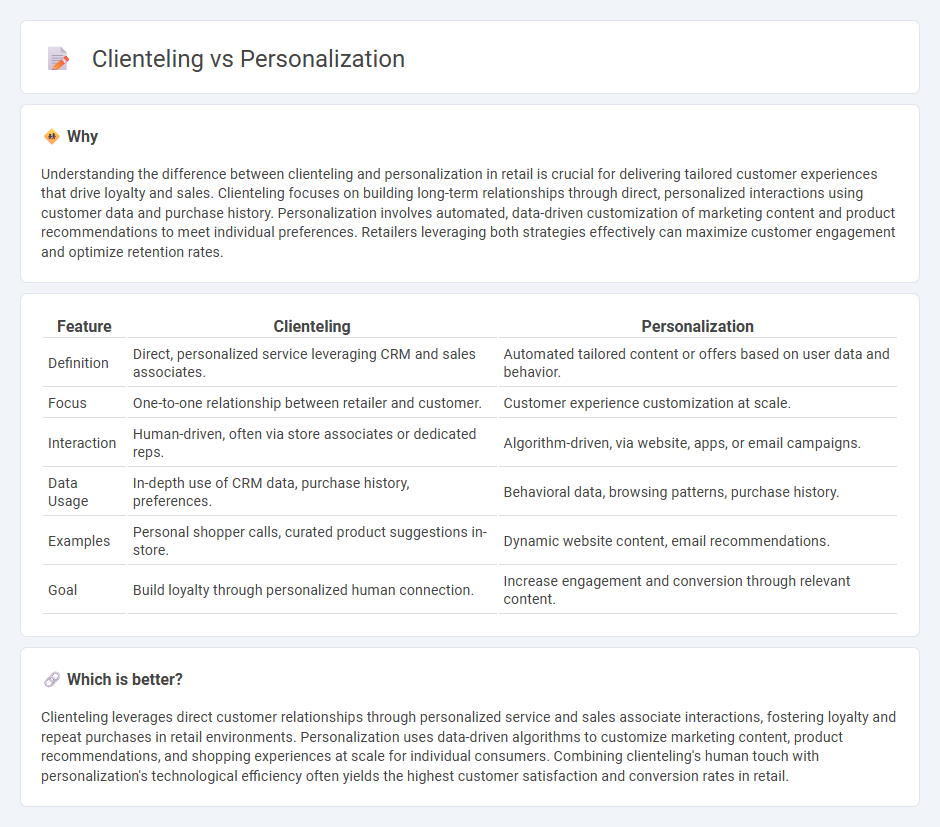
Clienteling leverages direct customer relationships through personalized service and detailed purchase histories to enhance loyalty and increase sales in retail. Personalization uses data-driven insights, including browsing behavior and preferences, to tailor marketing offers and shopping experiences at scale. Explore how integrating clienteling with personalization can transform retail strategies and boost customer satisfaction.
Why it is important
Understanding the difference between clienteling and personalization in retail is crucial for delivering tailored customer experiences that drive loyalty and sales. Clienteling focuses on building long-term relationships through direct, personalized interactions using customer data and purchase history. Personalization involves automated, data-driven customization of marketing content and product recommendations to meet individual preferences. Retailers leveraging both strategies effectively can maximize customer engagement and optimize retention rates.
Comparison Table
| Feature | Clienteling | Personalization |
|---|---|---|
| Definition | Direct, personalized service leveraging CRM and sales associates. | Automated tailored content or offers based on user data and behavior. |
| Focus | One-to-one relationship between retailer and customer. | Customer experience customization at scale. |
| Interaction | Human-driven, often via store associates or dedicated reps. | Algorithm-driven, via website, apps, or email campaigns. |
| Data Usage | In-depth use of CRM data, purchase history, preferences. | Behavioral data, browsing patterns, purchase history. |
| Examples | Personal shopper calls, curated product suggestions in-store. | Dynamic website content, email recommendations. |
| Goal | Build loyalty through personalized human connection. | Increase engagement and conversion through relevant content. |
Which is better?
Clienteling leverages direct customer relationships through personalized service and sales associate interactions, fostering loyalty and repeat purchases in retail environments. Personalization uses data-driven algorithms to customize marketing content, product recommendations, and shopping experiences at scale for individual consumers. Combining clienteling's human touch with personalization's technological efficiency often yields the highest customer satisfaction and conversion rates in retail.
Connection
Clienteling in retail enhances personalization by using customer data and purchase history to tailor interactions and recommendations. Personalized experiences boost customer loyalty and increase sales by addressing individual preferences and needs. Retailers leverage clienteling tools such as CRM systems and AI analytics to deliver targeted product suggestions and exclusive offers.
Key Terms
Customer Data
Personalization leverages customer data to deliver tailored experiences across digital platforms, using algorithms to analyze behavior and preferences. Clienteling builds deeper relationships by empowering sales associates with detailed customer profiles and purchase histories to provide personalized in-store service. Explore how advanced customer data strategies can transform both personalization and clienteling for your business.
Segmentation
Segmentation is the cornerstone of both personalization and clienteling, enabling businesses to categorize customers into distinct groups based on demographics, behaviors, and purchase history. Personalization leverages segmentation to deliver tailored marketing messages at scale, enhancing customer engagement and conversion rates. Explore how advanced segmentation techniques can transform your personalization and clienteling strategies for deeper customer connections.
Relationship Management
Personalization tailors marketing efforts based on individual customer data to enhance user experience, while clienteling involves direct, personalized interactions between sales associates and clients to foster deeper relationships and loyalty. Effective relationship management integrates both strategies, leveraging data-driven insights to anticipate customer needs and utilizing personal engagement to build trust and long-term commitment. Explore how combining personalization and clienteling transforms customer relationship management for sustained business growth.
Source and External Links
What is Marketing Personalization? | Salesforce US - Personalization uses data on customer behavior and preferences to tailor marketing messages and content, improving customer experience, loyalty, and revenue by delivering the right message to the right person at the right time.
What Is Personalization? Personalization Definition and Benefits - Personalization involves tailoring services or products to individual or group needs using customer data and predictive technology, distinguishing it from customization where customers control the modifications.
Personalization - Wikipedia - Personalization broadly means tailoring products or services for individuals, often leveraging data like web browsing and location, to improve marketing, sales, and customer satisfaction across various sectors.
 dowidth.com
dowidth.com